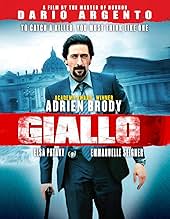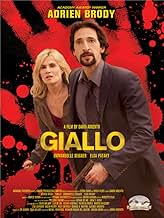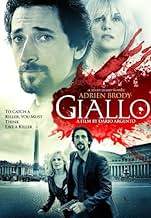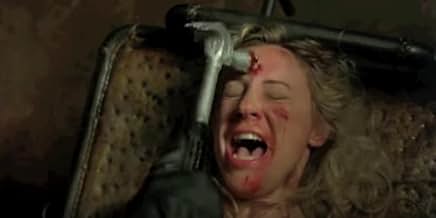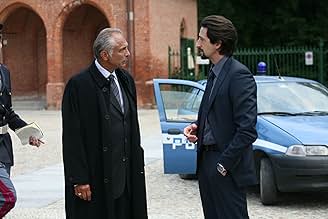VALUTAZIONE IMDb
4,5/10
6326
LA TUA VALUTAZIONE
Una donna teme che sua sorella possa essere stata rapita. L'ispettore Enzo Avolfi teme molto di più. Insieme cercano di salvarla da un sadico killer conosciuto con il nome di Giallo.Una donna teme che sua sorella possa essere stata rapita. L'ispettore Enzo Avolfi teme molto di più. Insieme cercano di salvarla da un sadico killer conosciuto con il nome di Giallo.Una donna teme che sua sorella possa essere stata rapita. L'ispettore Enzo Avolfi teme molto di più. Insieme cercano di salvarla da un sadico killer conosciuto con il nome di Giallo.
- Regia
- Sceneggiatura
- Star
- Premi
- 1 vittoria in totale
Adrien Brody
- Inspector Enzo Avolfi
- (as Byron Deidra)
- …
Valentina Izumi
- Keiko
- (as Valentina Izumì)
Giuseppe Loconsole
- Butcher
- (as Giuseppe Lo Console)
Recensioni in evidenza
If a single trait characterizes Dario Argento's 21st century output, it's its self-referentiality. Always a cine-literate filmmaker, his recent material has verged almost on self-parody. Amid all this, a generation of filmmakers have grown up with his films and been influenced by them, some more profoundly than others. Some, like Tim Burton, have assimilated his visual style into their own. Others have been more flippant in their appropriation of Argentoisms, with Quentin Tarantino lifting the music from The Bird with the Crystal Plumage for use in Death Proof, and Diablo Cody including a conversation debating the merits of Argento relative to H.G. Lewis in Juno. In effect, "Argento" has become something of a buzzword for a certain type of movie brat: a slightly edgy (but not too edgy) name they can mention to show that they're a little off the beaten track (but not too far off).
Oddly enough, Giallo represents something of a hybridization of the director's self-referentiality and the sort of fan idolatry that champions his films for their more superficial elements while ignoring the qualities that truly mark them out. Although the first credit at the end of the film reads "written and directed by Dario Argento", the original script in fact originated from two American fans, Jim Agnew and Sean Keller, with Argento essentially being brought on as a director for hire. This is not the first time this has happened: the two episodes he directed for the largely disappointing Masters of Horror series also originated from other writers, much to their detriment. (If Pelts had been directed by Eli Roth, I doubt it would have been appreciably different.) While Giallo's script is nothing remarkable, the overall execution is handled with considerably more flair than Jenifer or Pelts. This may be because Argento is on familiar stomping ground, with the Italian locations lending an air of natural class. Giallo is far from the bland, anonymous piece of work for hire that many feared it would be. While Frederic Fasano's cinematography lacks the verve of a Tovoli or even a Debie, and Marco Werba's Herrmannesque score alternates between effective and intrusive, there are little Argentoisms throughout, mainly in the lightly humorous moments. Likewise, an early sequence at an opera recalls Argento's 1987 masterpiece of the same name, while the oddly ambiguous final frame is reminiscent of The Cat O' Nine Tails.
That said, Giallo's most direct counterpart is The Card Player, and it's tempting to see them as two sides of the same coin. However, while The Card Player was clinical, high-tech and almost bloodless, Giallo goes in the opposite direction. Its set design hearkens back to the past, from Avolfi's dingy basement office to the foregrounding of Turin's picturesque monuments and buildings. The violence is also ramped up a notch, and it's tempting to view the film as Argento's reaction to the recent spate of so-called "torture porn" movies. The director has made conflicting statements as to his opinion of these films, but the lengthy scenes of Elsa Pataky being menaced and tortured in the killer's grimy underground lair are more reminiscent of Saw or Hostel than anything in Argento's past filmography.
And there's the rub: despite being marketed as a return to the genre that made a name for Argento in the 1970s, Giallo... well, isn't actually a giallo. The plot operates more as a cross between a cop thriller and a gore-soaked torture flick, the title referring solely to the killer's jaundiced skin. His face is seen almost from the start and his identity is ultimately not hugely important. Far more interesting is the way in which he and Avolfi are constructed as two sides of the same coin, both pariahs who operate in dark underground lairs and have suffered violent, traumatic pasts. As with much of his past work, Argento seems to be actively encouraging a Jungian reading. At times, this becomes a little too on the nose, with the casting of the killer... well, it's an intriguing choice but ultimately one that will either baffle people or have them slapping their foreheads at its obviousness.
With one notable exception, the cast acquit themselves reasonably well. The elephant in the room is Adrien Brody, who not only receives top billing but also an executive producer credit, performing uncredited script doctoring duties and making key decisions about the score (including nixing Argento's regular collaborator Claudio Simonetti). His role is an odd one, and it's far from the vanity project I expected. Avolfi is not particularly pleasant: he's distant, smarmy and reckless, and an act he committed in the past further blurs the line between him and the killer. Unfortunately, the specifics of this event, revealed around two-third of the way through the film, sent the audience at the screening I attended into fits of hysterics. More problematic in my mind, however, is Brody's performance. He seems to be imitating any number of 40s film noir detectives, but comes across as a mumbling buffoon whose reactions and line delivery always seem to be at odds with what's actually happening. He's not the first Oscar-winning actor to work with Argento, but he IS one of Argento's least convincing protagonists.
Giallo is a decent offering from a director whose work of late has been decidedly patchy. While I'm sure the usual battle lines will be drawn, with fans alternating between branding it a return to form and proclaiming it to be proof that he is a has-been, the truth is somewhere in the middle. No, it's not the next Profondo Rosso, but anyone who expected otherwise would simply be deluding themselves. It's substantially better than either of Argento's Masters of Horror outings, a step up from Mother of Tears, and a superior thriller to Do You Like Hitchcock? It's also more engaging than the overrated Sleepless and about on par with the underrated The Card Player, a film that for me improves with each subsequent viewing. Problems aside, Giallo is surprisingly good fun.
Oddly enough, Giallo represents something of a hybridization of the director's self-referentiality and the sort of fan idolatry that champions his films for their more superficial elements while ignoring the qualities that truly mark them out. Although the first credit at the end of the film reads "written and directed by Dario Argento", the original script in fact originated from two American fans, Jim Agnew and Sean Keller, with Argento essentially being brought on as a director for hire. This is not the first time this has happened: the two episodes he directed for the largely disappointing Masters of Horror series also originated from other writers, much to their detriment. (If Pelts had been directed by Eli Roth, I doubt it would have been appreciably different.) While Giallo's script is nothing remarkable, the overall execution is handled with considerably more flair than Jenifer or Pelts. This may be because Argento is on familiar stomping ground, with the Italian locations lending an air of natural class. Giallo is far from the bland, anonymous piece of work for hire that many feared it would be. While Frederic Fasano's cinematography lacks the verve of a Tovoli or even a Debie, and Marco Werba's Herrmannesque score alternates between effective and intrusive, there are little Argentoisms throughout, mainly in the lightly humorous moments. Likewise, an early sequence at an opera recalls Argento's 1987 masterpiece of the same name, while the oddly ambiguous final frame is reminiscent of The Cat O' Nine Tails.
That said, Giallo's most direct counterpart is The Card Player, and it's tempting to see them as two sides of the same coin. However, while The Card Player was clinical, high-tech and almost bloodless, Giallo goes in the opposite direction. Its set design hearkens back to the past, from Avolfi's dingy basement office to the foregrounding of Turin's picturesque monuments and buildings. The violence is also ramped up a notch, and it's tempting to view the film as Argento's reaction to the recent spate of so-called "torture porn" movies. The director has made conflicting statements as to his opinion of these films, but the lengthy scenes of Elsa Pataky being menaced and tortured in the killer's grimy underground lair are more reminiscent of Saw or Hostel than anything in Argento's past filmography.
And there's the rub: despite being marketed as a return to the genre that made a name for Argento in the 1970s, Giallo... well, isn't actually a giallo. The plot operates more as a cross between a cop thriller and a gore-soaked torture flick, the title referring solely to the killer's jaundiced skin. His face is seen almost from the start and his identity is ultimately not hugely important. Far more interesting is the way in which he and Avolfi are constructed as two sides of the same coin, both pariahs who operate in dark underground lairs and have suffered violent, traumatic pasts. As with much of his past work, Argento seems to be actively encouraging a Jungian reading. At times, this becomes a little too on the nose, with the casting of the killer... well, it's an intriguing choice but ultimately one that will either baffle people or have them slapping their foreheads at its obviousness.
With one notable exception, the cast acquit themselves reasonably well. The elephant in the room is Adrien Brody, who not only receives top billing but also an executive producer credit, performing uncredited script doctoring duties and making key decisions about the score (including nixing Argento's regular collaborator Claudio Simonetti). His role is an odd one, and it's far from the vanity project I expected. Avolfi is not particularly pleasant: he's distant, smarmy and reckless, and an act he committed in the past further blurs the line between him and the killer. Unfortunately, the specifics of this event, revealed around two-third of the way through the film, sent the audience at the screening I attended into fits of hysterics. More problematic in my mind, however, is Brody's performance. He seems to be imitating any number of 40s film noir detectives, but comes across as a mumbling buffoon whose reactions and line delivery always seem to be at odds with what's actually happening. He's not the first Oscar-winning actor to work with Argento, but he IS one of Argento's least convincing protagonists.
Giallo is a decent offering from a director whose work of late has been decidedly patchy. While I'm sure the usual battle lines will be drawn, with fans alternating between branding it a return to form and proclaiming it to be proof that he is a has-been, the truth is somewhere in the middle. No, it's not the next Profondo Rosso, but anyone who expected otherwise would simply be deluding themselves. It's substantially better than either of Argento's Masters of Horror outings, a step up from Mother of Tears, and a superior thriller to Do You Like Hitchcock? It's also more engaging than the overrated Sleepless and about on par with the underrated The Card Player, a film that for me improves with each subsequent viewing. Problems aside, Giallo is surprisingly good fun.
The high point in the film comes midway in the form of Adrian Brody's childhood flashback: the camera heaves this side and that inside an amber-lit room as though floating in the air while a music box lullaby that brings back memories of Goblin's School at Night theme from Profondo Rosso chimes in the background. Other than that, the movie might as well have been called "Routine Slasher" because there's nothing that recalls the glorious days of the Italian giallo here, no wink or homage or black-gloved killer stalking distraught heroines in kitsch/chic Rome apartments, countryside villas, and medieval architecture and certainly none of the Technicolor phantasmagoria Argento and his peers conjured on celluloid 30 years ago because anyone who has followed Argento's career knows he has been working in dark muted DV canvases for the past 10 years, this absence of style flooded with wooden acting, bad English from non-English speaking actors, and a script the sum of plot contrivance happenstance and logic jumps. Some will argue these have been staples of Argento's career and I will disagree because their place has always been peripheral to a certain grand guignol aesthetic by whose outrageousness, stylistic or otherwise, not only have they been relegated to the margins but they have made perfect "sense" there in the margins as part of Argento's style (or Italian horror film-making in general). If Mother of Tears was a bold step in the direction of Phenomena's schizophrenic conclusion, this is a step backwards to the undistinguished workmanlike nature of Il Cartaio and Ti Piace Hitchcock. Everything here is generic. The score sounds like Batman Returns throwaways (Claudio Simonetti's absence is sorely felt), the villain is a curious mixture of pathetic and creepy, Argento's stylized violence is conspicuously absent. This is a serial killer movie trying to balance between crime procedural and slasher such as one may find in Lionsgate's STD catalogue. If you're looking for the giallo homage the title promises, you'll find it in Sleepless. This is a routine affair not worthy of the master's name or his fans' time and money.
Many people have compared this film to 2004's Eyes of Crystal, and I have no doubt that Argento was influenced by said film, but one thing I do want to say is that Giallo has much cleaner and more precise cinematography, and that is a huge improvement over Eyes of Crystal's jerky and fast camera movement style. I know that it was popular in the 00's, and even up until only a few years ago, but it's always been a style I've hated.
At any rate, this isn't exactly a great effort from late Argento. A hell of a lot better than Dracula 3D, but what isn't?
Sleepless is much better than this, as is The Stendhal Syndrome and Trauma. Just about the only post-Opera film it does overtake is Phantom of the Opera, and again, what doesn't?
Giallo is honestly somewhat of a disappointment, especially considering the pretty involving beginning.
Visually however, it is somewhat of a treat. And for me, visuals are even more important than plot. What this IS lacking is atmosphere, pacing, and tension- in favour of gore and torture. Not a good trade off.
Dario Argento's latest "Giallo" is definitely brutal and grim, but regretfully still not a genuine throwback to the old-fashioned years of the Giallo; a sub genre of horror that Argento pretty much co-founded as well. This is one of the first times in his career that Argento didn't write the original screenplay himself, but he easily could have, since the film is chock-full of his usual trademarks, including misogynist torture, macho cop characters and a killer character with a hideous appearance and sick persona. In the city of Turin, a hood-capped killer abducts pretty young girls in his taxi and takes them to his secret liar where he has an operating table and a wide selection of delightful torture devices. When the killer was just a baby, apparently his heroine-addicted prostitute of a mother dropped him off at a nunnery in a plastic bag. I suppose that causes something irreversible damage to the fragile mind of a young boy. He also has a liver disease that makes the color of his skin kind of yellow; hence the title. When he kidnaps the gorgeous young model Celine, her older sister Linda teams up with Inspector Enzo Avolfi, who's actually a pretty introvert and reasonably creepy individual himself. The plot of "Giallo" is ultra-thin and not nearly as imaginative as they used to be, with a truckload of red herrings and more twists than a French mountain road, but there are still multiple moments of gripping suspense. The violence, however, is following the trend of the nowadays torture porn flicks (like "Hostel" and "Saw") and just comes across as repulsive, gratuitous and uncompromising. The sniveling killer pulls teeth and carves up the girls' pretty faces like he's on the set of the umpteenth unnecessary torture porn flick instead of a Dario Argento Giallo homage. The murders in Gialli movies have always been sadistic and gruesome, but at least they were often presented in style. But enough complaints now, as "Giallo" undeniably still is a worthwhile film for Dario Argento fanatics like myself and many others. I'm sick and tired of reading stuff like how the legendary Italian director Dario Argento lost his magical touch and ought to retire! As far as I'm concerned, Argento is still the only one who delivered a genuine Giallo in the post-2000's (with "Sleepless") and his other efforts like "The Third Mother", "Do you like Hitchcock" and the two episodes in Masters of Horror are fantastic entertainment.
On the part of promotion this title couldn't been better. Dario Argento, the master of old school giallo's made a flick called, Giallo. For all those who think that he isn't softened they will be disappointed by this thriller, Yes, this is definitely not a giallo.
"Giallo" films are characterized by extended murder sequences featuring excessive bloodletting, stylish camera-work and unusual musical arrangements. The literary whodunit element is retained, but combined with modern slasher horror, while being filtered through Italy's longstanding tradition of opera and staged grand guignol drama. They also generally include liberal amounts of nudity and sex.
None of this is included here. Why it is called Giallo, which means yellow is because once the killer is revealed, in the first part, you can see that his face is yellow due hepatitis.
I didn't had any difficulty with the flick itself which do has a few typical gory Argento shots but the acting of Emmanuelle Seigner (Linda) couldn't convince me. Adrian Brody (Inspector Enzo Avolfi) did look like those typical smoking Italian detectives and reminded me of a Tom Savini look-a-like.
I understand that Argento geeks will hate this but it's worth watching. A mediocre flick.
Gore 2/5 Nudity 0,5/5 Effects 3/5 Story 3/5 Comedy 0/5
"Giallo" films are characterized by extended murder sequences featuring excessive bloodletting, stylish camera-work and unusual musical arrangements. The literary whodunit element is retained, but combined with modern slasher horror, while being filtered through Italy's longstanding tradition of opera and staged grand guignol drama. They also generally include liberal amounts of nudity and sex.
None of this is included here. Why it is called Giallo, which means yellow is because once the killer is revealed, in the first part, you can see that his face is yellow due hepatitis.
I didn't had any difficulty with the flick itself which do has a few typical gory Argento shots but the acting of Emmanuelle Seigner (Linda) couldn't convince me. Adrian Brody (Inspector Enzo Avolfi) did look like those typical smoking Italian detectives and reminded me of a Tom Savini look-a-like.
I understand that Argento geeks will hate this but it's worth watching. A mediocre flick.
Gore 2/5 Nudity 0,5/5 Effects 3/5 Story 3/5 Comedy 0/5
Lo sapevi?
- QuizActor Adrien Brody sued the film's producers and financial backers when they failed to pay him his full wage for appearing in the film. After successfully blocking the film's release in court, the makers eventually paid him his outstanding money.
- BlooperCorpse on autopsy table is moving her eyes.
- Citazioni
Inspector Enzo Avolfi: Got you, you yellow fuck!
- ConnessioniReferenced in Midnight Movie Review: Halloween Horror Top 25, nr. 18: Giallo (2010)
I più visti
Accedi per valutare e creare un elenco di titoli salvati per ottenere consigli personalizzati
Dettagli
- Data di uscita
- Paese di origine
- Siti ufficiali
- Lingue
- Celebre anche come
- Giallo/Argento
- Luoghi delle riprese
- Lungo Po Armando Diaz, Torino, Piemonte, Italia(Linda's appartment)
- Aziende produttrici
- Vedi altri crediti dell’azienda su IMDbPro
Botteghino
- Budget
- 14.000.000 USD (previsto)
- Lordo in tutto il mondo
- 50.113 USD
- Tempo di esecuzione
- 1h 32min(92 min)
- Colore
- Mix di suoni
- Proporzioni
- 1.85 : 1
Contribuisci a questa pagina
Suggerisci una modifica o aggiungi i contenuti mancanti


